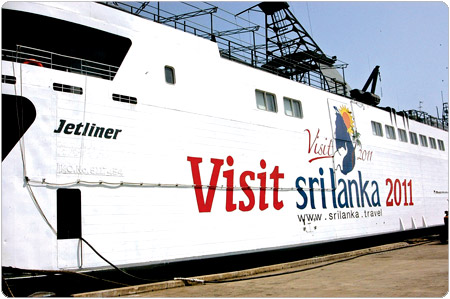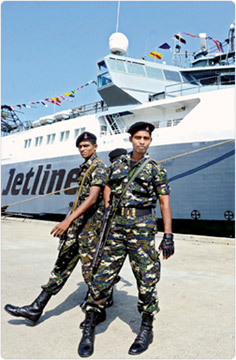|
Jetliner – Protector in war and peace:
The voyage that made Naval troops victorious
By Ranil WIJAYAPALA

It
was a memorable day in June 2008. I was getting ready to board the
Jetliner, the biggest troops carrier of the Sri Lanka Navy, which has
now become one of the most sought after places for the public and
corporate sector to conduct events including weddings.
My journey on board that ship was not to participate in any dinner or
fun event, as it happens today, but to observe one of the largest
operations launched by the Sri Lanka Navy during the humanitarian
operation carried out by the Security Forces from 2006 to 2009.
It was the Jetliner that created a bridge for the Security Forces
serving in the Jaffna peninsula with those in the South as more than 80
percent of the transport requirement of the single largest deployment of
troops numbering closer to 40,000 in the Jaffna peninsula was
facilitated by the Jetliner.
That was besides the hectic operations carried out by the Sri Lanka
Navy to create a ‘fence’ around this small island, shielding the terror
operation to smuggle arms into the North and the East by various means
and also carrying out massive operations beyond the shores of the
country in search of floating warehouses of the LTTE.
Therefore, the battle of the Navy in the Security Forces’ march
towards defeating the terror outfit in the country was fought in a wider
front in the facilitation of the ground troops who engaged in a
face-to-face battle with the Tigers in the battlefront.
Among all those operations carried out in a wider front by the Navy,
the Jetliner operation was one of the most sensitive as it involved the
lives of nearly 3,000 Security Forces personnel at a time amidst the
LTTE making use of their best strategies to target the vessel.
So the weekly operation of the Jetliner, carrying nearly 3,000 troops
to Kankesanthurai and bringing back another 3,000 to Trincomalee, gave
sleepless nights to the officers involved in this operation and also for
the three Forces Commanders involved in this operation from the
operations rooms in Colombo.
No one wanted to take any risk with regard to the Jetliner operation
as a single mistake would lead to a turning point in the war against
LTTE terror.
Highest level of secrecy
 Secrecy
was maintained at its highest level about the operations of the Jetliner
and the venue where the ship was docked changed from one place to
another in the Trincomalee harbour as regular operations at one place
would make it a target of the LTTE. Secrecy
was maintained at its highest level about the operations of the Jetliner
and the venue where the ship was docked changed from one place to
another in the Trincomalee harbour as regular operations at one place
would make it a target of the LTTE.
Therefore, the transportation of troops from the transit camps in
Trincomalee also had to be carried out secretively as it would give
signals to the enemy about the operation.
For the thousands of soldiers who went on leave after hectic duties
in the major battlefront in the Jaffna peninsula, the Jetliner became a
saviour as it was a nightmare for them to board on a flight from the
Palaly airport with the restricted number of flights and the huge demand
for seats.
So the journey on board the Jetliner, with the crew of more than 100
Navy personnel and another 3,000 security Forces personnel, a majority
of them from the Sri Lanka Army, was a memorable occasion in my
journalistic career in the battlefront in the North and the East since
it was not just a sea journey, but an amazing opportunity to observe one
of the challenging sea voyages undertaken by a Navy fighting the most
ruthless terror outfit in the world.
It was the biggest operation carried out by the Navy and all sectors
had to be on duty to make it a success. The three Forces Commanders,
Commanders of the Eastern and Northern Naval Areas, the Dvora Squadron
and Air Force helicopters had to be on duty to make that operation a
success, as quick action was needed to react to any eventuality they
faced during the voyage. A flotilla of Dvoras had to give close
protection to the ship while intelligence operations had to be carried
out to monitor the LTTE communications, to check whether there were any
possible attempts by them to attack the vessel.
Sri Lanka Air Force helicopters had to be on vigil, following the
route of the Jetliner, to observe any strange objects or suspicious
movements in the sea during the voyage of the Jetliner from Trincomalee
to Kankesanthurai.
Desperation
The desperation of the LTTE to target the Jetliner was displayed
after the recovery of explosive-laden boats positioned at several
locations along the coastal line in the north of Mullaitivu and the
unearthed torpedoes from locations close to Visuamadu on a tip-off given
by surrendered LTTE cadre.
If any of those attempts by the LTTE had been successful, the
celebrations today over the defeat of the LTTE would have been a distant
dream for us.
However, the Sri Lanka Navy with the support of the Army and the Air
Force, made all those attempts impossible for the LTTE and even foiled
all attempts by the LTTE to sink this troop carrier along with the
troops. They had to sail far from land to avoid such attempts by the
LTTE, thus creating a conducive environment to observe any suspicious
movements of the LTTE towards the ship.
Though things happened secretly at the Trincomalee harbour, the
arrival of the Jetliner at the Kankesatnurai harbour could be observed
by any outsider after the ship passes Point Pedro on the eastern tip of
the Jaffna peninsula.
So mechanisms were put in place to have the fastest loading and
unloading process, to unload the 3,000 troops and logistics and load
another set of 3,000 troops along with their logistics while supplying
fuel for the vessel.
It was amazing that the process took only 30 minutes.
It was also a very sensitive process as it was a place where more
than 6,000 Security Forces personnel gathered at one small location.
Therefore, at the height of the battles, the movement of the artillery
batteries of the LTTE had to be closely monitored during this period as
they had the KKS harbour within their artillery range.
So the operation of the Jetliner by the Sri Lanka Navy made things
happen in the Jaffna peninusla even at a time when all air operations to
the peninsula was impossible, while facing the biggest challenge posed
by the most effective sea wing of the LTTE armed with suicide squadrons.
It was after the liberation of the entire Jaffna -Kandy A-9 road in
mid January 2009 that the Sri Lanka Navy breathed a sigh of relief as
all battlefronts in the North were made accessible through ground. They
continued with this huge task until the A-9 road was made safer for
troop transportation after ground troops carried out operations further
towards the east of the A-9 road.
Troop transportation
The operation of the Jetliner through the transportation of troops to
and from the Jaffna peninsula till the end of the humanitarian operation
made the biggest contribution to the war against terrorism on the part
of the Sri Lanka Navy, on par with their contribution to the same after
destroying eight LTTE arms smuggling vessels from 2006 to 2008.
Today, as one of the victorious navies in the world, the Sri Lanka
Navy sets examples to other navies sharing the knowledge they absorbed
by facing swarms of Black Tigers in flotilla of small boats through the
introduction of similar small fast attack craft through the Special Boat
Squadron and Rapid Action Boat Squadron at the height of the battle,
thus making the LTTE think twice before they launched any attack.
Therefore, the contribution made by the Sri Lanka Navy in the process
of defeating the LTTE, the only terror outfit armed with its own
sea-going wing, has not only contributed to creating a terror-free sea
territory around Sri Lanka, but also led towards international maritime
security by making their contribution to eliminate a terror outfit that
would have become a challenge for the entire global maritime security
network.
That is why all Sri Lankans today love to board a ship like the
Jetliner to mark the most important days in their lives as it is a
symbol of safety and security; it performed its role at the height of
battle by ensuring the safety of thousands of troops personnel.
So, it has become the symbol of protection both in war and peacetime
in Sri Lanka, thus symbolising the great contribution of the Sri Lanka
Navy to make Mother Sri Lanka victorious in its battle against
terrorism.
Today, when we mark the third anniversary of that great victory that
freed Sri Lanka from terrorism, we should salute all those officers and
sailors of the Sri Lanka Navy who made that great victory possible
through their supreme sacrifices. |

